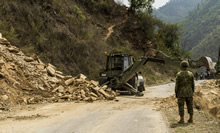How the DART responds to emergencies
Related links
Canada sends the Disaster Assistance Response Team (DART) to help when natural disasters and emergencies happen in other countries. Canada sends the DART on request, when local responders are overwhelmed and people have nowhere else to turn. The DART can leave on very short notice to anywhere in the world, and it can operate for up to 60 days.
How the DART operates
Canada sends the DART to regions where it has government support and where it will not face organized resistance.
The DART is made up of Canadian Armed Forces (CAF) and civilian experts from across Canada who are trained and ready to go out on short notice. Its equipment is also maintained for an immediate response.
What happens on a DART operation
The DART works primarily to:
- stabilize the main impacts of the disaster, working with national and regional governments and other agencies;
- prevent secondary impacts of the disaster; and
- gain time until national and international aid groups arrive to provide long-term aid to the region.
The DART is not designed to provide first response services. It does not conduct search and rescue or emergency trauma care. Instead, it can help when local governments and groups that provide primary health care and drinking water are overstretched.
A typical DART operation will provide:
- water purification (up to 50,000 litres of safe drinking water per day);
- primary medical care (serving up to 250 to 300 outpatients and 10 inpatients per day depending on needs); and
- engineering help (field engineers, construction engineers and heavy equipment).
How a DART mission is launched
When a country is facing a crisis, it can request help from Canada. This request may come straight from a country that is in need. It may also come from an international organization such as the United Nations (UN).
The Canadian government decides whether to help based on recommendations from its departments. Global Affairs Canada (GAC) is the lead department when the government of Canada responds to a humanitarian crisis abroad. The CAF supports GAC when help is requested. The CAF is equipped to assist when disasters strike and people in other countries are in crisis.
The Canadian Disaster Assessment Team (CDAT) is a group of experts from GAC and the CAF. When a request for help comes in, the CDAT goes to the disaster zone and assesses the needs on the ground. It then recommends whether to send CAF assets and the DART to respond to the crisis. The Canadian government makes the final decision.
